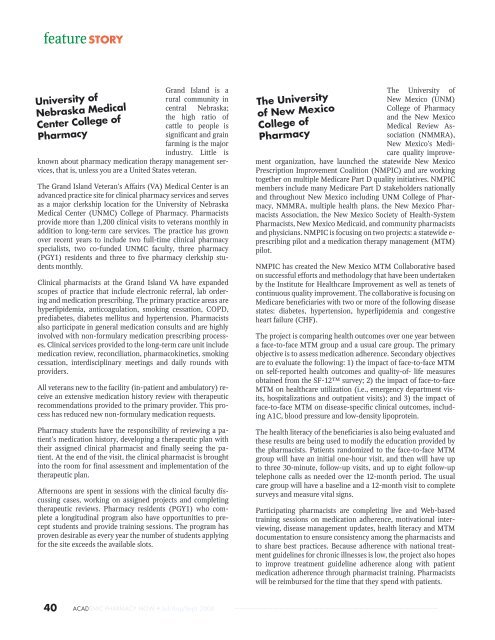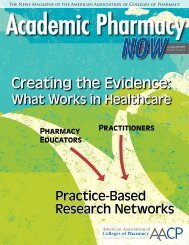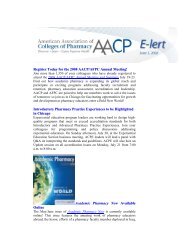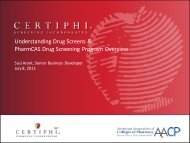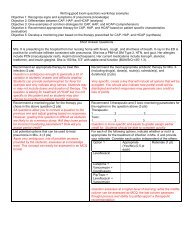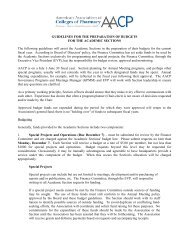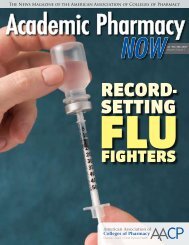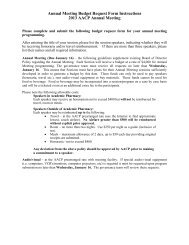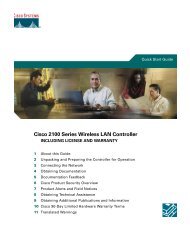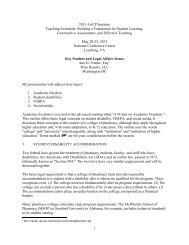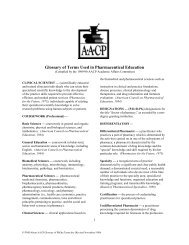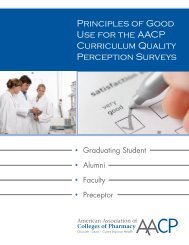Jul Aug 2008 APN.pdf - AACP
Jul Aug 2008 APN.pdf - AACP
Jul Aug 2008 APN.pdf - AACP
Create successful ePaper yourself
Turn your PDF publications into a flip-book with our unique Google optimized e-Paper software.
feature s t o r y<br />
University of<br />
Nebraska Medical<br />
Center College of<br />
Pharmacy<br />
40<br />
Grand Island is a<br />
rural community in<br />
central Nebraska;<br />
the high ratio of<br />
cattle to people is<br />
significant and grain<br />
farming is the major<br />
industry. Little is<br />
known about pharmacy medication therapy management services,<br />
that is, unless you are a United States veteran.<br />
The Grand Island Veteran’s Affairs (VA) Medical Center is an<br />
advanced practice site for clinical pharmacy services and serves<br />
as a major clerkship location for the University of Nebraska<br />
Medical Center (UNMC) College of Pharmacy. Pharmacists<br />
provide more than 1,200 clinical visits to veterans monthly in<br />
addition to long-term care services. The practice has grown<br />
over recent years to include two full-time clinical pharmacy<br />
specialists, two co-funded UNMC faculty, three pharmacy<br />
(PGY1) residents and three to five pharmacy clerkship students<br />
monthly.<br />
Clinical pharmacists at the Grand Island VA have expanded<br />
scopes of practice that include electronic referral, lab ordering<br />
and medication prescribing. The primary practice areas are<br />
hyperlipidemia, anticoagulation, smoking cessation, COPD,<br />
prediabetes, diabetes mellitus and hypertension. Pharmacists<br />
also participate in general medication consults and are highly<br />
involved with non-formulary medication prescribing processes.<br />
Clinical services provided to the long-term care unit include<br />
medication review, reconciliation, pharmacokinetics, smoking<br />
cessation, interdisciplinary meetings and daily rounds with<br />
providers.<br />
All veterans new to the facility (in-patient and ambulatory) receive<br />
an extensive medication history review with therapeutic<br />
recommendations provided to the primary provider. This process<br />
has reduced new non-formulary medication requests.<br />
Pharmacy students have the responsibility of reviewing a patient’s<br />
medication history, developing a therapeutic plan with<br />
their assigned clinical pharmacist and finally seeing the patient.<br />
At the end of the visit, the clinical pharmacist is brought<br />
into the room for final assessment and implementation of the<br />
therapeutic plan.<br />
Afternoons are spent in sessions with the clinical faculty discussing<br />
cases, working on assigned projects and completing<br />
therapeutic reviews. Pharmacy residents (PGY1) who complete<br />
a longitudinal program also have opportunities to precept<br />
students and provide training sessions. The program has<br />
proven desirable as every year the number of students applying<br />
for the site exceeds the available slots.<br />
academic Pharmacy now <strong>Jul</strong>/<strong>Aug</strong>/Sept <strong>2008</strong><br />
The University<br />
of New Mexico<br />
College of<br />
Pharmacy<br />
The University of<br />
New Mexico (UNM)<br />
College of Pharmacy<br />
and the New Mexico<br />
Medical Review Association<br />
(NMMRA),<br />
New Mexico’s Medicare<br />
quality improve-<br />
ment organization, have launched the statewide New Mexico<br />
Prescription Improvement Coalition (NMPIC) and are working<br />
together on multiple Medicare Part D quality initiatives. NMPIC<br />
members include many Medicare Part D stakeholders nationally<br />
and throughout New Mexico including UNM College of Pharmacy,<br />
NMMRA, multiple health plans, the New Mexico Pharmacists<br />
Association, the New Mexico Society of Health-System<br />
Pharmacists, New Mexico Medicaid, and community pharmacists<br />
and physicians. NMPIC is focusing on two projects: a statewide eprescribing<br />
pilot and a medication therapy management (MTM)<br />
pilot.<br />
NMPIC has created the New Mexico MTM Collaborative based<br />
on successful efforts and methodology that have been undertaken<br />
by the Institute for Healthcare Improvement as well as tenets of<br />
continuous quality improvement. The collaborative is focusing on<br />
Medicare beneficiaries with two or more of the following disease<br />
states: diabetes, hypertension, hyperlipidemia and congestive<br />
heart failure (CHF).<br />
The project is comparing health outcomes over one year between<br />
a face-to-face MTM group and a usual care group. The primary<br />
objective is to assess medication adherence. Secondary objectives<br />
are to evaluate the following: 1) the impact of face-to-face MTM<br />
on self-reported health outcomes and quality-of- life measures<br />
obtained from the SF-12 survey; 2) the impact of face-to-face<br />
MTM on healthcare utilization (i.e., emergency department visits,<br />
hospitalizations and outpatient visits); and 3) the impact of<br />
face-to-face MTM on disease-specific clinical outcomes, including<br />
A1C, blood pressure and low-density lipoprotein.<br />
The health literacy of the beneficiaries is also being evaluated and<br />
these results are being used to modify the education provided by<br />
the pharmacists. Patients randomized to the face-to-face MTM<br />
group will have an initial one-hour visit, and then will have up<br />
to three 30-minute, follow-up visits, and up to eight follow-up<br />
telephone calls as needed over the 12-month period. The usual<br />
care group will have a baseline and a 12-month visit to complete<br />
surveys and measure vital signs.<br />
Participating pharmacists are completing live and Web-based<br />
training sessions on medication adherence, motivational interviewing,<br />
disease management updates, health literacy and MTM<br />
documentation to ensure consistency among the pharmacists and<br />
to share best practices. Because adherence with national treatment<br />
guidelines for chronic illnesses is low, the project also hopes<br />
to improve treatment guideline adherence along with patient<br />
medication adherence through pharmacist training. Pharmacists<br />
will be reimbursed for the time that they spend with patients.<br />
The Ohio State<br />
University<br />
College of<br />
Pharmacy<br />
A young mother walks up to the<br />
prescription drop-off window at<br />
her local Kroger pharmacy. The<br />
pharmacist behind the counter<br />
greets her by name as she hands<br />
over a prescription.<br />
“Your son’s still got that ear infection?”<br />
he says as he types up her information.<br />
They talk about cough medications, decongestants and potential side effects<br />
of the antibiotic being prescribed. She asks him if antibacterial hand wipes are<br />
truly effective in preventing the spread of illness.<br />
Welcome to the new face of pharmacy, where quality practice is as much about<br />
communicating with patients as it is about dispensing medication.<br />
To Dr. Jennifer Rodis, assistant professor of clinical pharmacy, the changing<br />
role of the community pharmacist is an exciting development she is passionate<br />
about promoting. For the past three years, she has coordinated a program<br />
called Partner for Promotion, which pairs fourth-year pharmacy students with<br />
community pharmacists to develop patient education materials, health screenings<br />
and other services.<br />
The idea to create the program, Rodis said, was a no-brainer. “Who do we see<br />
more often than anyone else in the healthcare profession? It’s our pharmacist,”<br />
she said.<br />
“In the last five to 10 years, we’ve been seeing a real trend: People are seeing<br />
multiple physicians, they’re not affording their medications so they’re not taking<br />
them, and then they’re not sure why they’re taking the pills they do take,”<br />
Rodis said.<br />
Working with two other faculty—Drs. <strong>Jul</strong>ie E. Legg and Kristin A. Casper —<br />
and funding from an Excellence in Engagement grant, Rodis made the program<br />
a vehicle for helping pharmacists and pharmacy students develop resources<br />
and procedures for providing patient care services.<br />
For 10 months, one or two Ohio State pharmacy students work closely with a<br />
community pharmacist, from a Kroger or CVS pharmacy to an independent<br />
business like Foster’s Pharmacy in Mount Vernon, Ohio, to identify patient<br />
education needs — cholesterol screening and education, hypertension adherence<br />
programs and diabetes screening and education, for example — and create<br />
an advanced patient care service.<br />
“We have a set of online education modules that follow a step-wise approach<br />
to developing the patient care service. They’re not the clinical information or<br />
therapeutic information on a disease or the drugs, because for the most part<br />
the pharmacists already have that,” Rodis said.<br />
Since 2005, the program has helped implement services in 19 sites across central<br />
Ohio and parts of Kentucky.<br />
Rodis is proud of a program she says no other college of pharmacy can quite<br />
match. At other schools, she explains, it’s typically the faculty who go into the<br />
pharmacies, create programs and then let the pharmacists run it. At Ohio State,<br />
the hope is that by having pharmacists work with students to develop patient<br />
care services specific to their pharmacies, there will be more ownership of that<br />
service and a deeper understanding of the process behind creating it.<br />
University of<br />
Washington<br />
School of<br />
Pharmacy<br />
feature s t o r y<br />
The Washington State Department of Health<br />
Board of Pharmacy recently granted the UW<br />
School of Pharmacy a license to open a nondispensing<br />
MTM pharmacy. It is one of the first of<br />
its kind in Washington state.<br />
This new pharmacy is an integral component of<br />
the Department of Pharmacy’s effort to develop<br />
an MTM training program within the school.<br />
Drs. Annie Lam and Peggy Odegard, named Herb<br />
and Shirley Bridge endowed professors this past<br />
fall, are using the funds from the professorship<br />
to create this program. Lam and Odegard saw a<br />
need for it after learning that some Washington<br />
pharmacists have been overwhelmed by MTM requests<br />
since Medicare Part D went into effect in<br />
January 2006. Given that pharmacy students have<br />
also requested MTM training in recent years, this<br />
seemed like the right time to pursue this project.<br />
The school is collaborating with the Washington<br />
State Pharmacy Association to bridge the service<br />
gap for practitioners who have more requests for<br />
these Medicare-related services than they can<br />
satisfy. Ultimately, the program seeks to help<br />
community pharmacists meet the demand while<br />
also creating an effective teaching resource for<br />
the School of Pharmacy.<br />
“Our goal is not to be competitive with our professional<br />
colleagues who are practicing pharmacists,<br />
but rather to provide them with MTM<br />
support while also assuring our graduates are<br />
well-prepared to provide these services,” says<br />
Odegard.<br />
The School of Pharmacy’s MTM program will<br />
focus on three primary areas — implementing<br />
an MTM curriculum for students, creating an<br />
onsite MTM consulting service and conducting<br />
research.<br />
Some of the initial research, says Odegard, will<br />
assess best practices for pharmacists providing<br />
these services to older adults. If all goes according<br />
to plan, the school will begin offering the<br />
training classes to students this fall.<br />
academic Pharmacy now <strong>Jul</strong>/<strong>Aug</strong>/Sept <strong>2008</strong> 41


